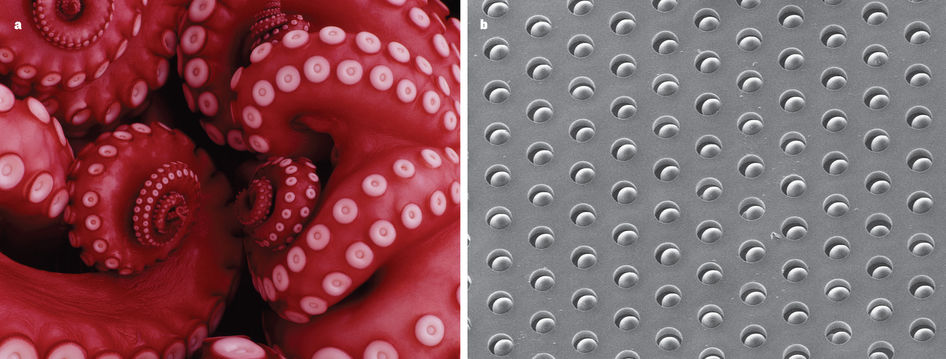You might know the frustration of trying to get a suction cup to stick: cleaning the sucker and surface over and over again, pushing on the sucker for increasing amounts of time and with increasing amounts of force… But nothing helps, the basket of shower gels and shampoos, or whatever you’re trying to attach to a wall/window/door (or maybe you are trying to climb a tower) just slowly slides down – if you’re lucky – or falls to the ground – on your toes, if you’re not so lucky.
Well, there might be some hope. Researchers are looking to nature to find a solution to this everyday frustration – because I’m positive this was the incentive: minimising shower rage. There is a whole field based on nature-inspired solutions and products, mostly grouped under the name Biomimetics, because why would you try to reinvent the wheel if nature has evolved a useful means of transportation?
Back to the suckers. In June, I came across a News&Views article that made me do a double take. You see, I had a brief moment of surprise when I thought the Nature journal had taken a liking to hentai (if you don’t know what this is, please do not google it, you have been warned). But it was not what I thought; “How to suck like an octopus” dealt on materials science, and how to make rubber sheets that can stick to surfaces. In other words: how to make better suckers!
It turns out that octopuses use suction cups to attach to rocks and to grab things. And it turns out the special shape of their suckers enhances that adhesion. Boom, let’s try and create a material that does the same!
Inspired by Octopus vulgaris, researchers tried to recreate the ideal adhesive material that sticks well to surfaces but also is able to detach easily. Octopus vulgaris‘ trick is a dome-shaped bulge at the bottom of the suction cup (see figure). This “dome in a cup” structure – mimicked by micrometre-sized hole with a dome in it (see figure, again) – enhances adhesion to wet surfaces by providing capillary forces between the dome and the substrate.
On dry surfaces, the presence of the domes does not increase adhesion but doesn’t cause any decreased adhesion either. The only difference between the octopus suckers is that octopuses have muscles in the suckers to flex, expand and contract them, increasing control of the adhesion and detachment. There are still some things to mimic then; it’s always nice to have something for the “Future Work” bit of a paper.
I think biomimetics is like super cool, though I have to admit that sometimes the applications seem unrealistic or too far-fetched; in this case, the authors suggest applications in manufacturing – transport of materials – and biomedical applications such as wound dressing. However, I still believe there is great value in biomimetic research: better understanding – the biomimetic device can teach us of the workings of the in natura equivalent (I know that’s not what in natura means) – and it’s just fun to do!
The News&Views author agrees:
“Applications aside, understanding and mimicking the fundamental science of attachment strategies used by sea creatures can just be plain fun.”

References:
Original Letter: http://www.nature.com/nature/journal/v546/n7658/full/nature22382.html
Suction Cup Guy: https://www.youtube.com/watch?v=7XCk3AtUbvA

